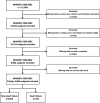Iron deficiency: prevalence, mortality risk, and dietary relationships in general and heart failure populations
- PMID: 38562191
- PMCID: PMC10982413
- DOI: 10.3389/fcvm.2024.1342686
Iron deficiency: prevalence, mortality risk, and dietary relationships in general and heart failure populations
Abstract
Background: Iron deficiency (ID) is the most common nutritional deficiency, with little research on its prevalence and long-term outcomes in the general population and those with heart failure (HF). Both the relationships between dietary iron and ID, as well as dietary folate and ID, are understudied.
Methods: We used data from the National Health and Nutrition Examination Survey from 1999 to 2002 to investigate the prevalence, prognosis, and relationship between dietary and ID defined by different criteria in the general population (n = 6,660) and those with HF (n = 182).
Results: There was no significant difference in the prevalence of ID between HF patients and the general population after propensity score matching. Transferrin saturation (TSAT) <20% was associated with higher 5-year all-cause mortality (HR: 3.49, CI: 1.40-8.72, P = 0.007), while ferritin <30 ng/ml was associated with higher 10-year (HR: 2.70, CI: 1.10-6.67, P = 0.031) and 15-year all-cause mortality (HR: 2.64, CI: 1.40-5.00, P = 0.003) in HF patients. Higher dietary total folate but dietary iron reduced the risk of ID (defined as ferritin <100 ng/ml) in HF patients (OR: 0.80; 95% CI: 0.65-1.00; P = 0.047).
Conclusions: The prevalence of ID was identical in HF and non-HF individuals. Ferritin <30 ng/ml was associated with long-term outcomes whereas TSAT <20% was associated with short-term prognosis in both the general population and HF patients. A diet rich in folate might have the potential for prevention and treatment of ID in HF patients.
Keywords: ferritin; folate; heart failure; iron deficiency; long-term prognosis; transferrin saturation.
© 2024 Sun, Wang, Han, Chen, Wang and Zhong.
Conflict of interest statement
The authors declare that the research was conducted in the absence of any commercial or financial relationships that could be construed as a potential conflict of interest.
References
-
- Parikh A, Natarajan S, Lipsitz SR, Katz SD. Iron deficiency in community-dwelling US adults with self-reported heart failure in the national health and nutrition examination survey III: prevalence and associations with anemia and inflammation. Circ Heart Fail. (2011) 4(5):599–606. 10.1161/circheartfailure.111.960906 - DOI - PMC - PubMed
LinkOut - more resources
Full Text Sources
Research Materials
Miscellaneous


